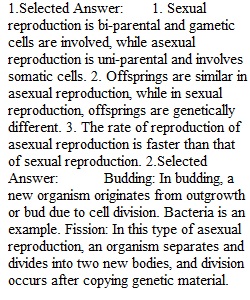


Q • Question 1 3 out of 3 points Describe 3 differences between sexual and asexual reproduction. • Question 2 4 out of 4 points Briefly describe the following four types of asexual reproduction: ? budding ? fission ? fragmentation ? parthenogenesis • Question 3 4 out of 4 points If asexual reproduction produces more offspring in a shorter time than sexual reproduction (see fig46.3), then why does sexual reproduction even exist? What is the benefit? What type of environmentwould favor asexual reproduction? Sexual reproduction? • Question 4 5 out of 7 points Use your paper worksheet to label the following structures (be sure to also know their functions for your final exam). • Question 5 10 out of 10 points Use your paper worksheet to label the following structures (be sure to also know their functions for your final exam). • Question 5 10 out of 10 points Use your paper worksheet to label the following structures (be sure to also know their functions for your final exam). • Question 5 10 out of 10 points Use your paper worksheet to label the following structures (be sure to also know their functions for your final exam).
View Related Questions